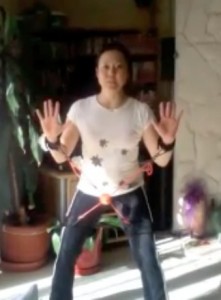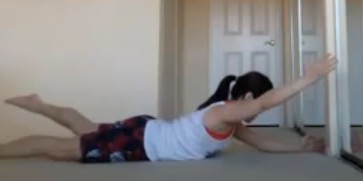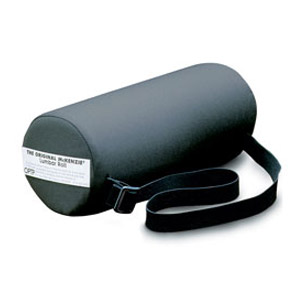http://www.youtube.com/watch?v=bLzn4Y_U44w
If you need a challenge in your workout while improving your posture and strengthening your back muscles, you’ll want to throw these advanced Pilates mat exercises into the mix. These three exercises can be performed anywhere, and provide big benefits and efficiency that target a bunch of muscles all at once: core, back and neck extensors, scapular stabilizers, arms, shoulders, glutes, hamstrings and calves!
Here are the BIG 3:
1. Swimmer
Target Muscles: Postural muscles of the neck, upper and lower back, deltoids, hamstrings, glutes, calves
How To Do It: Lie on your stomach, with your arms and legs extended. Make sure your palms face in and your pull your shoulders away from your ears. Lift your right arm and left leg, then switch. Continue alternating arm and leg lifts for 30 seconds, twice, or 60 seconds once through.
2. Leg Pull Front
Target Muscles: Core, lats, triceps, glutes, hamstrings, calves, quadriceps
How To Do It: Get into plank position, making sure that your shoulders are over your wrists and navel is drawn in. Inhale and lift your right leg up. Exhale and shift your shoulders back and point your right foot. Inhale and shift your shoulders forward. Exhale and lower your right foot down. That’s one rep. Repeat on the left and do 5 reps on each side.
3. Leg Pull Bicycle
Target Muscles: All postural muscles, triceps, shoulders, core, glutes, hamstrings, calves
How To Do It: Get into a reverse plank position, making sure shoulders are over wrists. Lift your buttocks high in the air so that your body is in one straight line. Bend your right knee to your chest, extend the foot up to the ceiling, and then down. That’s 1 rep. Do 5, and repeat on the left side. Rest for 10 seconds and reverse the bicycle: Lift your leg to the ceiling, bend your knee to your chest and extend your foot out for 5 reps. Repeat on the other side.
Once you start doing these exercises consistently, in addition to getting strong, you’ll notice that your posture will improve and that you’ll starte getting compliments on your toned body! Have fun and if you need modifications, make sure to ask me. If you want to learn these exercises in person, or need help with designing a program that addresses your posture, make sure to send me an
email here, or call me at (310) 463-4363!
 I attended a spine seminar in Los Angeles several weeks ago. Alex McKechnie, the Sports Performance Coach for the Los Angeles Lakers, gave a lecture on how he performs core stabilization using a device he invented, the Core X.
I attended a spine seminar in Los Angeles several weeks ago. Alex McKechnie, the Sports Performance Coach for the Los Angeles Lakers, gave a lecture on how he performs core stabilization using a device he invented, the Core X.
